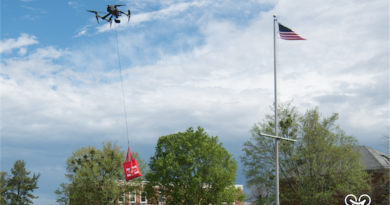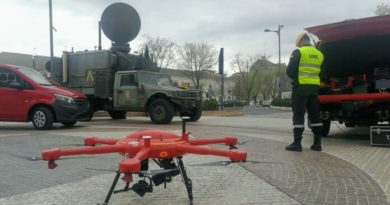Drones and the Coronavirus: From Crisis to Opportunity
![]()
By Millie Radovic via Droneii. Originally published: Apr. 2020
As the entire world scrambles to react to the global health crisis caused by the spread of the new coronavirus and the COVID-19 illness, conversations about automation and the role of robotics in society have never been more relevant. With the number of those infected by the new coronavirus passing 1,000,000 and the number of deaths passing 50,000, two main concerns sit at the forefront of government decisions: 1) How do we slow down the spread of this highly infectious virus? And, 2) How do we keep economies afloat and deliver essential goods amid the first lockdown of this scale that the modern world has ever seen? Robotics in general, and especially commercial drones, have a major role to play in both of these endeavours.
Drones Helping Battle the Virus
First and foremost, drones have already proven to be useful tools in curbing the spread of the virus and aiding efforts to contain and battle the COVID-19 disease. There are in fact at least five tangible ways in which drones can and are being used right now:
Medical Drone Deliveries
The most prominent use case for drones in the coronavirus crisis so far have definitely been medical drone deliveries. The Chinese drone delivery operator, Antwork, recently joined efforts to battle the virus by delivering medical supplies. Our recent interview with their COO, Zhao Liang, explains this endeavour further. Medical drone deliveries can be a game changer for efforts to battle the virus not only because they can speed up deliveries of essential supplies and samples, but also because they reduce the exposure of crucial medical staff.
Moreover, medical drone delivery operators – from Antwork in China to Swiss Post with Matternet in Switzerland, Wing and also UPS in the US – are amongst the most commonly authorised drone delivery companies out there. This means that as far as regulations are concerned, especially in the case of the Part 135 certified UPS, medical drone deliveries of test samples, masks, donations and much more could be scaled throughout this year and into 2021 to help hospitals and other public health stakeholders.
Surveillance & Monitoring
The key policy currently in place to slow to the spread of the virus, or ‘flatten the curve’ of new cases is social distancing. This has involved the closing of Horeca (hotels, restaurants and cafes) in most countries and banning the public gatherings of people in order to limit physical contact. While in some nations this has been an effective policy, in others it has been more difficult to enforce – be it because individuals do not want to follow the new restrictions or because they are unaware about what they entail. Therefore, drones are now being used in the Netherlands, Belgium, China, Mongolia, France and Spain to monitor public spaces and help authorities disband any social gatherings which may pose a risk to society. While the use of drones for surveillance and monitoring does introduce sensitive debates about privacy and individual rights, current policies in place are all managed by temporary emergency powers given to governments in a time of crisis. The introduction of drones simply alleviates the risk that members of the police have the be exposed to and plays a huge role especially in countries where police forces are underfunded and understaffed.
Broadcasting
In addition to monitoring the streets, authorities are able to further reduce the risk and exposure of police officers and other personnel by using drones to broadcast messages and spread information about procedures. This use case has been seen not only in Europe but further afield in less developed nations, like Mongolia. Given the unprecedented nature of the current public health crisis, broadcasting messages about social distancing and with key information about nearby hospitals is key to helping residents remain informed and participate in the global efforts.
Spraying
Finally, other than developing a vaccination and slowing down the spread of the virus, governments are also concerned about improving public health infrastructure in order to be able to handle high numbers of patients in need of intensive care. In many countries this has involved adapting large spaces into temporary hospitals and in some cases like China, Germany, Russia and the United States, the building of new emergency hospitals and units to help care for infected patients away from those hospitalised for other reasons and therefore highly vulnerable to COVID-19. Drones frequently used for surveying have a major role to play in helping governments build more efficiently and with minimum human involvement (and thus exposure to the virus).
Surveying
Meanwhile, the most direct use of drones so far has most definitely been their use for spraying disinfectant in China and Dubai. So far little information is known about the conditions in which this is done, i.e. with or without any people present on the street and what kind of liquid is sprayed. There are also concerns that this could be very harmful for the rest of the flora and fauna there. However, authorities have confirmed that the liquids they are using are WHO approved. Indeed, if all the key aspects of the application, including the safety and security of residents, are taken into account this looks to be a promising use case for improving sanitation – especially in impoverished urban areas where it is especially poor.



